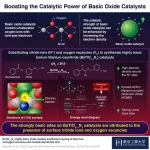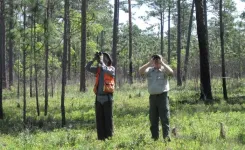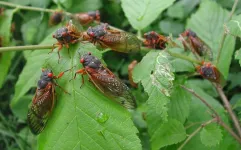(Press-News.org) New Haven, Conn. — It is well known that people who have lived through traumatic events like sexual assault, domestic abuse, or violent combat can experience symptoms of post-traumatic stress disorder (PTSD), including terrifying flashbacks, severe anxiety, and uncontrollable thoughts about the incident. But what exactly happens in the brains of PTSD patients as they recall these traumatic events? Are they remembered the same way as, say, the loss of a beloved pet — or, for that matter, a relaxing walk on the beach?
A new study co-led by Yale researchers finds that the brain activity triggered by recollections of traumatic experiences among people with PTSD is in fact markedly different from that which occurs when remembering sad or “neutral” life experiences.
In the study, which involved 28 different patients diagnosed with PTSD, researchers found that brain patterns were consistent across all individuals when they recalled their more typical life experiences. But when reminded of traumatic events from their past, neural responses differed significantly among the individuals.
“When people recall sad or neutral events from their past experience, the brain exhibits highly synchronous activity among all PTSD patients,” said Yale’s Ilan Harpaz-Rotem, professor of psychiatry and psychology at Yale and co-senior author of the paper. “However, when presented with stories of their own traumatic experiences, brain activity was highly individualized, fragmented, and disorganized.
“They are not like memories at all.”
The study, conducted with researchers at Icahn School of Medicine at Mount Sinai in New York, is published Nov. 30 in the journal Nature Neuroscience.
For the study, the researchers asked each of the 28 participants a range of questions, which pertained to their traumatic experiences, events in their lives that caused sadness (such as the death of a family member), and moments when they felt relaxed. Each person’s story was written down and then read back to them while they underwent fMRI (functional magnetic resonance imaging) scans, which are used to map brain activity based on blood flow.
The researchers found that activity in the hippocampus — the area of the brain that forms memories of our experiences — followed similar patterns of activity among all subjects when they were reminded of sad or relaxing experiences from their lives, suggesting typical normal memory formation.
But when stories about their traumatic experiences were read back to them, the similarities in hippocampal activity among the group members disappeared. Instead, the hippocampus of each subject exhibited highly individualized and fragmented activity, unlike the more synchronous patterns of brain activity during normal memory formation.
The results could explain why PTSD patients have difficulty recalling traumatic experiences in a coherent way and hints at why these past experiences can trigger disabling symptoms, the researchers say.
These insights may help psychotherapists guide PTSD patients to develop narratives about their experiences which may help them eliminate the sense of immediate threat caused by their trauma, Harpaz-Rotem said.
END
Study reveals distinct brain activity triggered by memories of trauma
2023-11-30
ELSE PRESS RELEASES FROM THIS DATE:
Armed to the hilt: Study solves mystery behind bacteria’s extensive weaponry
2023-11-30
New study tackles the mystery of why bacteria often carry diverse ranges of weapons.
The findings show that different weapons are best suited to different competition scenarios.
Short-range weapons help bacteria to invade established communities; long-range weapons are useful once established.
A new study led by the University of Oxford has shed light on why certain species of bacteria carry astonishing arsenals of weapons. The findings, published today in the journal Nature Ecology & Evolution, could help us to engineer microbes that can destroy deadly pathogens, reducing our reliance on antibiotics.
Many species of bacteria possess ...
Gladstone team uncovers why maternal diabetes predisposes babies to heart defects
2023-11-30
SAN FRANCISCO—November 30, 2023—When women with diabetes become pregnant, they face not only the typical challenges of pregnancy and impending parenthood, but also a scary statistic: they’re five times more likely to have a baby with a congenital heart defect.
Researchers at Gladstone Institutes have now discovered why that is, identifying the cells and molecules that go awry in the developing hearts of fetuses in women with diabetes. They found that a small subset of cells destined to become part of the heart’s aorta and pulmonary artery have unusually high levels of retinoic acid activity, which coaxes them to behave more like cells found ...
CityU researchers tackle a century-old teletraffic challenge to enhance medical and public service efficiency
2023-11-30
Efficiently meeting the growing demand for public services in metropolitan areas has long been a persistent challenge. A research team at City University of Hong Kong (CityU) has developed a novel performance evaluation method, which marks a major breakthrough in tackling a century-old problem of evaluating blocking probabilities in queueing systems with overflow, providing ways to allocate limited resources better. With the remarkable advances in computational efficiency and accuracy, the method has great potential to optimise the performance of numerous telecommunication networks and even medical care systems, ultimately enhancing ...
Bringing asteroids to class: COSPAR joins new Erasmus+ program
2023-11-30
COSPAR and the Erasmus+ Education Programme
COSPAR’s participation in Erasmus+ programmes is part of the COSPAR Panel on Education’s new approach to its mission of developing “means and media to encourage and spread space-related education”. The StudenTs As plaNetary Defenders (StAnD) project aims to engage primary and secondary school students in the subject of asteroids, meteors, and planetary defence.
The 36-month StudenTs As plaNetary Defenders (StAnD) programme brings asteroids, comets, meteors and meteorites to the classroom using carefully prepared activities and experiments. The programme includes the installation of meteor detection cameras in participating ...
Developing a superbase-comparable BaTiO3−xNy oxynitride catalyst
2023-11-30
Basic oxide catalysts contain oxygen ions with unpaired electrons that can be shared with other species to facilitate a chemical reaction. These catalysts are widely used in the synthesis of chemicals, pharmaceuticals, and petrochemicals. There have been efforts to improve the catalytic power of these catalysts by improving their basicity or the ability to donate electrons or accept hydrogen ions. Various strategies include doping the catalyst with highly electronegative cations such as alkali metals, substituting oxide ions ...
Hurricanes boost cone production in longleaf pine
2023-11-30
New research on tree reproduction is helping solve a puzzle that has stumped tree scientists for decades. Many tree species exhibit a reproductive phenomenon known as “masting”, where individual trees have very low seed production in most years followed by a sudden burst of seed production that is synchronized over large parts of its range. The reason for this coordinated reproduction within a species is unclear.
A new study by scientists at The Jones Center at Ichauway and the USDA Forest Service Southern Research Station showed ...
Scientists uncover how fermented-food bacteria can guard against depression, anxiety
2023-11-30
University of Virginia School of Medicine researchers have discovered how Lactobacillus, a bacterium found in fermented foods and yogurt, helps the body manage stress and may help prevent depression and anxiety. The findings open the door to new therapies to treat anxiety, depression and other mental-health conditions.
The new research from UVA’s Alban Gaultier, Ph.D., and collaborators is notable because it pinpoints the role of Lactobacillus, separating it out from all the other microorganisms that naturally live in and on our bodies. These organisms are collectively known as the microbiota, and scientists have increasingly ...
Broadband buzz: Periodical cicadas' chorus measured with fiber optic cables
2023-11-30
Annapolis, MD; November 30, 2023—Hung from a common utility pole, a fiber optic cable—the kind bringing high-speed internet to more and more American households—can be turned into a sensor to detect temperature changes, vibrations, and even sound, through an emerging technology called distributed fiber optic sensing.
However, as NEC Labs America photonics researcher Sarper Ozharar, Ph.D., explains, acoustic sensing in fiber optic cables "is limited to only nearby sound sources or very loud events, such as emergency vehicles, car alarms, or cicada emergences."
Cicadas? Indeed, periodical cicadas—the ...
More than $13M awarded to study childhood obesity interventions in rural and minority communities in Louisiana and Tennessee
2023-11-30
BATON ROUGE – Pennington Biomedical Research Center and Vanderbilt University Medical Center have received $13.8 million for five years of research funding from the Patient-Centered Outcomes Research Institute to study the ideal “dose” of behavioral interventions to treat childhood obesity in rural and minority communities across Louisiana and Tennessee.
Pennington Biomedical’s Amanda Staiano and Vanderbilt University Medical Center’s Bill Heerman are co-principal investigators on the randomized, multisite trial.
Despite ongoing efforts, childhood obesity rates have continued to increase over the ...
Decoding past climates through dripstones
2023-11-30
“Dripstones, or speleothems, are unique natural archives - like Earth’s USB sticks. They store a wealth of information on past climate which helps us to better understand the environment in which early humans lived”, Jenny Maccali explains. She is a scientist at SapienCE Centre of Excellence, and has has lead the study, now published in Climate of the Past.
New perspective to ancient climate
South Africa has a highly dynamic climate resulting from its position at the convergence of two oceanic basins, the Atlantic Ocean to the west and the Indian Ocean to the east. ...






